|
|
Post by Seth Drakin of Monster Crap on Oct 23, 2007 20:54:44 GMT -5
 55. Smash Tennis No Information Available From My Sources.....Sorry |
|
|
|
Post by Seth Drakin of Monster Crap on Oct 23, 2007 21:00:49 GMT -5
One of the clues has been changed because I looked at the wrong game.
|
|
|
|
Post by Seth Drakin of Monster Crap on Oct 23, 2007 21:03:52 GMT -5
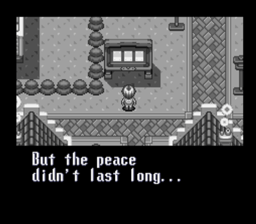 54. Robotrek Robotrek is a role-playing game released in 1994. It was published by Enix and developed by Quintet and Ancient for the SNES video game console. As its Japanese name implies, Robotrek was intended as a humorous game. Designed to appeal to a younger audience, Robotrek's main focus is on allowing the player to raise up to three robots which are built from spare parts that may be found, gained through battles, or generated by the player by means of the game's item combination system. The game is seen as very similar to Pokémon in that the protagonist does not himself fight, but sends out his robots to do so. Robotrek has similar gameplay to that of most RPG video games, with the notable exception that the main character is not the combatant, but rather, the robots he invents are. The robots are highly customizable, in aspects such as armaments, accessories, special attacks, body color and name. The player is allowed to build three of these robots. A sizable part of the game revolves around inventing items to improve the robots, producing weapons which range from swords and guns to exotic weapons such as a hammer that shoots its head off and various manners of shields, boots, and backpack accessories. Also customizable are the robot's stats, including HP, strength, defense, evasion, and speed. This system is based on what are called "Program Points". Initially, at level one, all robots have 40 Program Points, and as the character gains levels, he gets 10 more points each time. All robots have the same amount of points to spend on attributes. But one of the main features of the game's customization is having the ability to create your robots' own unique attacks, ranging from a dash & slash to an awesome explosion. Robotrek suffered from a notoriously bad translation, a problem exacerbated by the convoluted plot involving time travel. In one memorable exchange, one of the Hackers answers Dr. Akihabara's criticism of his loyalties by responding, "That's what you say, but Evil is good. Evil is the job." Battles are engaged by contact with the enemy on a map. The player usually attacks first, unless the enemy has caught the player's side or from behind. Battling in the game takes place on a battlefield under a variation of the ATB system, in which the player must wait for a gauge to fill up before acting. Only one robot may fight at any time (up against at most three enemies) instead of all of the robots fighting at once; you can switch between robots whenever its your turn at the cost of using that turn. During the player's turn, none of the enemies will act, and the robot is free to move around the battlefield and attack with one of its weapons. After the robot acts, a gauge appears with the letters E (empty) and F (full) at either end. Depending on the attack you use, that is how much of your gauge it will consume. Until the gauge reaches F, all enemies take turns attacking. Unlike most RPG video games, the character gains "Megs of Data" instead of experience points. Once enough Megs are obtained, the player gains a level. Also all enemies don't give money by default, but certain enemies do drop it on the map after being defeated. Most enemies will drop some item or low-level equipment, but these can be "Recycled" to make money. This battling system also introduces the concept of bonuses. During battle, a countdown begins with 10 x (number of enemies) seconds. If the battle is won within this time limit, the player gets a bonus of .1 x (tens digit + 1 of the time) Megs of data. Another bonus is that capsules appear on the battlefield while the countdown happens. If the player uses a melee attack on the capsules, the player receives an item, bonus megs, or it could be a fake and cause damage to the robot. If the countdown is up, the capsules explode (without damaging the robot). Lastly, if the robot makes any successful melee attack against an enemy, it adds .1 Megs of data to the bonus, assuming the player can defeat the enemy within the time limit. This could possibly be the precursor to the HP/MP bonuses in the Star Ocean series. Much of the game revolves around creating and combining items for your robots' benefit, and is essential to make higher-level equipment. The player can do these things through an invention machine (which is a large SNES controller, a screen, and bits of heavy machinery) and with the help of two gnomes and a series of books called "Inventor's Friend". As the player gains levels, he or she can read the Inventor's Friend books at the respective level the character is at or below. This helps with the creation of items. Items called Scrap aid with combining items for equipment. Each scrap has a base equipment component, and that can be used to upgrade various weapons or accessories. However, combinations to create higher-level equipment tend to be difficult to figure out. Weapons can also be strengthened by combining one weapon with the same type (swords for a Sword). A weapon can increase strength by nine times (called levels). The game takes place mostly on the planet Quintenix, but limited space travel is possible to the neighboring planet of Choco and a space fortress named Fortress. The main world map (on Quintenix only) features a straight path between locations and thus does not offer free exploring, but rather a series of triggered events. On the planet of Quintenix, where the situation has long been peaceful, a group calling themselves "The Hackers", headed by Blackmore, suddenly starts an uprising against the population by disrupting the peace of the town of Rococo (and elsewhere). The main character (who appears to be nameless) is the son of a famous inventor, Dr. Akihabara, who decides to move to Rococo. The main character soon sets off to find out that The Hackers want Dr. Akihabara for a sinister purpose, as Akihabara refuses an offer to join them. The story unfolds to the point where The Hackers' ultimate goal is the Tetron, a mysterious stone that allows viewers to observe events past and future and travel through time. The Tetron is later found out to be an invention of the main character's ancestor Rask and one of his friends, Gateau, finds the Tetron's potential as the key to controlling the universe by controlling time. Rask disregards that potential and hides the Tetron in shards throughout Quintenix. Gateau, who — presumedly — formed The Hackers later on, obtains the Tetron and attempts to proceed with his plan for universal domination, starting with Rask's home planet of Choco. It is up to the main character to stop Gateau in his space fortress. |
|
|
|
Post by Seth Drakin of Monster Crap on Oct 23, 2007 21:12:23 GMT -5
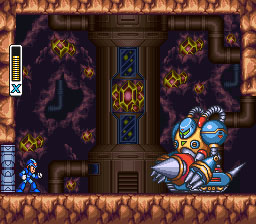 53. Mega Man X3 Mega Man X3 was released in 1995 by Capcom. It was the third game in the Mega Man X sub-franchise and the last to appear on the Super Nintendo. Like its predecessor, Mega Man X2, Capcom included the Cx4 chip to allow for some limited 3D graphics and transparency effects. Mega Man X3 was the first game in which Zero is a playable character in addition to X. The story of Mega Man X3 revolves around a Reploid scientist named Dr. Doppler. In the year 21XX, the threat of the Mavericks had been neutralized thanks to Doppler's technology, which prevented the Mavericks from going berserk. The reformed Reploids had formed an utopia near their new mentor called Doppler Town. It seemed that all was well, until the former Maverick Reploids suddenly reverted and once again began causing trouble. Dr. Doppler was held accountable, and X and Zero were sent out to contain the new threat. They were soon after called back to Maverick HQ, which was under attack by Doppler's forces. However, the two did not realize that while Doppler was indeed behind the new Maverick threat, someone else was pulling his strings. As if that wasn't bad enough, one of X and Zero's old enemies is back from the dead, ready to take them down. Mega Man X3 is an action game where the player is given a selection screen of stages to begin. When selected, the player uses Mega Man X to blast various enemies throughout the level and reach the boss character, where defeating it wins the stage and earns a new weapon for the player to utilize. Scattered throughout the stages are powerups used by X to enhance his attributes and obtain a wider range of skills: * Body Upgrades - Usually found in well-hidden areas, a projection of Dr. Light will give X encouragement and allow him to acquire an upgrade through use of a blue capsule: * Leg upgrade - Allows X to perform an air dash, either laterally or straight up. * Armor upgrade - Reduces the amount of damage that X takes by 50%, and creates a force field around X whenever he takes damage. * Helmet upgrade - Displays a simple map upon starting a stage to help uncover hidden items; also lists the three items in the currently-highlighted level on the stage select screen, in pink if they have not been collected and in gray if they have been. * X-Buster upgrade - Allows X to charge up a double shot, either unleashing one shot after the other or at the same time as a cross-shot. Also lets X charge special weapons. An additional chip upgrade can be supplanted to one of X's body upgrades by finding one of these pink capsules. Once one is taken however, X may not collect another chip upgrade nor may he replace his previous chip upgrade with another one: * Leg chip - Allows X to perform two air dashes in the same jump. * Armor chip - Improves the defense field around X. * Helmet chip - Regenerates X's life energy when he stands still; can also fill Sub-Tanks when X's life energy is full. * X-Buster chip - Allows X to instantly shoot stored energy (gained from taking damage) into fully charged shots. Health Supplements: * Heart Tanks - Increases the maximum amount of X's life energy by two bars, allowing him to survive through more damage; one is found in each of the eight main stages. * Sub-Tanks - Allows X to store extra energy which can be used to replenish life energy when it is low; four are found in the entire game, and they can only be filled by X and at full life. It takes 14 energy capsules to completely fill one tank, with large capsules counting for two. Ride Armor - Four separate items can be found that grant X the access to different ride armors when he reaches a certain platform, each with their own abilities and designated by a single letter: * Chimera (N) - This standard ride armor can jump, punch, and dash; in order to use the other ride armors, this one must be obtained. * Kangaroo (K) - In this ride armor, X can charge up a punch to launch the ride armor's fist for a longer-ranged attack. * Hawk (H) - This ride armor fires missiles and can hover in the air for a short time. * Frog (F) - This is the only ride armor that works underwater; it shoots missiles, and hops instead of walking. Other: * Gold Armor - If X gets all four body upgrades, all four Ride Armors, all four Sub Tanks, and all eight Heart Tanks, but none of the chips, a secret capsule in Doppler's first stage allows him to get all four chips at once. Not a full armor by itself, it is a gold recolor of the regular armor. X's health must be full before you could find this upgrade. * Z-Saber - In the second fortress stage, a bug-like miniboss blocks the way. If Zero is used to defeat this enemy, it crashes into him. Unable to continue further, Zero gives X his Z-Saber and leaves. Although this prevents you from calling Zero again for the rest of the game, and he will not appear in the ending, X is now able to use Zero's Z-Saber in the same way as him. By charging the X-Buster until he glows green, X will swing the Z-Saber after the double-shot attack, and it will launch an energy wave, extending the range of the attack. (If X does not obtain the X-Buster upgrade, he will only swing the sword after his fully-charged shot, and it will not shoot the energy wave.) The Z-Saber is powerful enough to defeat any boss in two hits, including Sigma. However, this will not work unless Vile has been destroyed with either the Spinning Blades or Ray Splasher. The Mavericks Are: * Blast Hornet * Blizzard Buffalo * Gravity Beetle * Toxic Seahorse * Volt Catfish * Crush Crawfish * Tunnel Rhino * Neon Tiger Sub-Bosses Are: * Mac A small-time Hunter who sides with Doppler early on, and captures X at Hunter HQ. He is quickly dealt with by Zero. * Maoh the Giant A giant Mechaniloid that Doppler sics on Hunter HQ. It has giant maces for hands. * Wormseeker R A immense caterpillar beneath the ground in Neon Tiger's stage. It drops two hard-to-destroy bouncing eggs every time it emerges, then travels through the air and burrows into another part of the floor or ceiling. * Genjibo and Shurikein In Blast Hornet's stage, a little firefly spawns a giant, 3D star, which whirls around the airplane hangar like a buzzsaw. When it simply goes back and forth on the ground, shooting it will make it jump. * Hotareeka This beast lurks under the dam in Toxic Seahorse's stage. It travels back and forth in the middle of the screen, dropping mines and firing missiles. * Hell Crusher This tank-riding fiend hides out in Tunnel Rhino's stage. * Rex-2000 In the first Doppler stage, this odd enemy marches around, guarding a device making the ceiling collapse, firing missiles from its back and energy blasts from its mouth. * Mosquitus This parasitic monster hangs out in Doppler's second stage, but only if Vile was destroyed in the first eight stages. If Zero beats him, the monster will catch him in a death grip and explode. Zero, however, shall just barely survive. He'll be unusable for the rest of the game, but before he leaves, he'll give X his Z-Sabre to use. * Godkarmachine O Inary Bit and Byte fuse together to form this ancient Egyptian/Buddhist-looking monstrosity. It pitches saber slices at you or tries to grab you with its flying arms. If you dash over and behind him, he'll summon pink homing shots. * Name Unknown In Doppler's second level (only if you defeat Vile-MX2 to gain the Z-saber) you will notice some changes, first of all, the baddies from Toxic Seahorse's level will have upgrades, there is the Dragonfly, and instead of a final confrontation with Vile-MX2, you will enter the gate, and fall into a deep underwater battleground where you fight an immense water machine. |
|
|
|
Post by Seth Drakin of Monster Crap on Oct 23, 2007 21:15:35 GMT -5
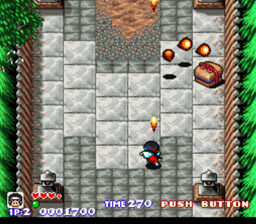 52. Pocky & Rocky Pocky & Rocky is a scrolling shooter video game with action elements licensed by Taito to Natsume, who developed and published the game for release in Japan in 1992 and the rest of the world in 1993. It is the sequel to the 1986 arcade game KiKi KaiKai (unofficiallly released in North America as Knight Boy) and follows the continued adventures of a young Shinto shrine maiden named Pocky (called "Sayo-chan" in the Japanese version) and her new companion, Rocky the Raccoon ("Manuke" in the original). The original title "KiKi KaiKai: Nazo no Kuro Manto" translates to "Mysterious Ghost World: Riddle of the Black Mantle" Set in Feudal Japan, Pocky & Rocky has the player assume the role of a young girl who, while tending to a shrine one night, is visited by Rocky, a tanuki and member of a group of yôkai known as the "Nopino Goblins", all of whom have recently been driven insane by an unknown force. Together, Pocky and Rocky must travel through several levels consisting of various ancient Japanese locales while battling a number of creatures from popular Japanese myth, including kappas, obake, and yûrei. Eventually, they must breach the stronghold of the mysterious Black Mantle, who has been using these monsters (collectively referred to as the "Gorgonzola Goblins") to fulfill his evil deeds. Whichever character the player chooses to play will make no difference in the outcome of the story. Pocky & Rocky takes place from a top-down perspective with the characters moving either horizontally or vertically through a level while defeating approaching enemies and destroying obstacles that may block the player's path. Pocky can use her o-fuda talismans (simply called "cards" in the English language version) to attack enemies from afar, or purification rod, which she swings at a wide arc, to hit ones close up. Likewise, Rocky can throw leaves across the screen or quickly turn his backside towards the enemy and swing his tail from side to side. By holding the short-ranged attack button down and then releasing it, Pocky does a spinning attack that can hit any enemy around her, while Rocky is able to transform into a statue, rendering him invulnerable to all attacks for a short time while leaving him immobile. Both characters can also slide across the ground, covering an area quickly. If a player bumps into the other while sliding, it will cause them to spin out of control across the screen, damaging any enemies they come in contact with, though the initial bump causes some damage to the receiving character. A limited-use special attack can be used to hit all the enemies present on the screen, and is only available once per life. Though most enemies only require a few attacks to defeat, boss monsters present at the end of each level take much more, and may require an additional use of strategy. Various power-ups can also be acquired that will increase the effectiveness of either Pocky or Rocky's attacks, such as making their projectiles larger or giving them the ability to throw multiple ones at once. Others include the ability to become invincible, or regain hit points, giving them more endurance. Each item obtained will add to the player's total score, and when a certain amount is reached, they are given an additional life, another chance to complete the current level. Three levels of difficulty can be selected before a player begins the game: easy, normal or hard. Selecting a higher difficulty will make the enemy creatures more difficult to defeat and provide a higher challenge to the player, as well as increase the number of hits required to defeat a boss. Defeating the game on a harder mode will not yield any greater ending or reward, and it is merely for the player's own gameplay preference. |
|
|
|
Post by Seth Drakin of Monster Crap on Oct 23, 2007 21:24:00 GMT -5
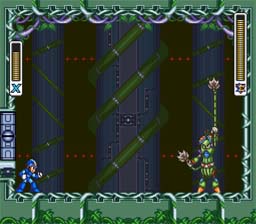 51. Mega Man X2 Mega Man X2 was released in 1994 by Capcom and is the second game in the Mega Man X sub-franchise. It used the same graphics engine from the first installment of the series, but Capcom included an in-cartridge enhancement known as the Cx4 chip to improve semitransparencies and allow for some 3D graphics in the game. Mega Man X3 was the only other game to ever use this chip. Like the first game, it's praised for having an excellent soundtrack. The subtitle Versus X-Hunters is given in the opening story; the Japanese version's full name is Rockman X2: Versus Counter-Hunters. The game was re-released on January 10th, 2006 as part of the Mega Man X Collection for the GameCube and PlayStation 2. Six months after defeating Sigma, X assumes leadership of the Maverick Hunters. Despite Sigma's death, the Maverick Rebellion continues. X has tracked the remaining Mavericks to a Reploid factory, and launches a full assault. But this was not the end of the war. Three of the Maverick leaders, Serges, Agile, and Violen, form a group called the "X-Hunters" ("Counter Hunters" in the Japanese version) and gain control of the North Pole. In the time between Sigma's demise and their sudden uprising, Serges has collected the parts of Zero, who had died in the first conflict. The X-Hunters contact the Maverick Hunters and taunt them with Zero's body, which they have split into three pieces, in order to lure out X, hoping to destroy him. Mega Man X2 is an action game, where the player is given a selection screen of stages to begin, When selected, the player uses Mega Man X to blast various enemies throughout the level and reach the boss character, where defeating it wins the stage and earns a new weapon to utilize for the player. The Mavericks Are: * Wire Sponge * Crystal Snail * Flame Stag * Magma Centipede * Morph Moth * Bubble Crab * Wheel Gator * Overdrive Ostrich The Sub-Bosses Are: * CF-0 A mass-produced robot X fights in the reploid factory. The CF-0s are enormous and strike with their mace-like arms and spiked feet. However, despite its size, a couple of shots in the head with the X-Buster would take it down in seconds. * Sea Canthiller This gigantic fish roams the deep seas of Bubble Crab's area. It chugs along at a snail's pace, firing torpedoes, dropping mines and scanning the depths with a searchlight. If X is caught by the beam, it'll start to sweep the area with a laser cannon. Destroying it is optional, but necessary if Agile resides in the X-Hunters' room. Using the charged-up Sonic Slicer will easily eliminate this enemy. * Old Robot and Paraloid S-38 Two of these lurk in the graveyard-like junkyard that Morph Moth controls. The Old Robot lurches around the screen, occasionally spitting a piece of trash. Only its stomach can be damaged by the player. The paraloid possesses the old robot, and will appear once the old robot is destroyed. After a few seconds, it will summon another robot to possess. It can only be destroyed between the robots it summons. Bubble Splash will easily destroy the paraloid and the old robot. * Chop Register This 3D sword is the first guardian of Magna Centipede's stage. It swings itself around to deflect shots, then pursues the player and either slices or thrusts. Only its blue handle can be damaged, which is hard to hit when the sword is swinging. The Bubble Splash, the Silk Shot, and the Magnet Mines seem to defeat it quickly, and the Giga Crush destroys it instantly. * Raider (Radar) Killer A Reploid in ambush that engages the player after a long hall of falling bricks in Magna Centipede's stage. If X doesn't avoid the scanner displays in the falling brick area, this guardian absorbs the data and becomes stronger, with 3 possible levels of difficulty. The only weapons which are consistently effective are the X-Buster, the Spin Wheel and the Speed Burner. * Savor Moon R This orb is frozen in place in Crystal Snail's stage. It does not attack on its own, but it sends a floating weapon out (and another when it is almost dead) that shoots lasers. The lasers reflect all over the room and are tricky to dodge. Spin Wheel seems to be the only effective weapon due to the fact that it will repeatedly cause damage if it lands near it. Its name seems to be a pun on the "Sailor Moon R" anime series. The X-Hunter Diversions Are: * Agile In Mega Man X2, Agile was an integral part of the X-Hunters, an organization that planned to unify Zero's broken parts and use him for their own twisted purposes. He and his two comrades, Serges and Violen, challenged X to collect Zero's parts. Agile, like many of the foes X faces, is arrogant, probably too much so. It's commonly believed that Agile is the leader of the X-Hunters, but his position is described as "Captain" while Serges is described as the actual leader. It would seem that he is in charge of the militaristic branch of the plans, such as strategies, while Serges holds the technical knowledge. He asks Serges how the plan is proceeding, as if he were in a position of leadership. Although he is greatly involved in the plan for the Unification, Serges is the forerunner of it. When Agile is first confronted, he fights using a Beam Sabre, and as his name implies, he's very fast, zipping back and forth across the room faster than X can dash. During the second fight with him, he appears manning a large capsule at the top of a room with spikes on the floor, firing projectiles of all sorts. In Mega Man Zero 2 Agile can be seen when a certain attack is used by Phoenix Magnion in the "destroy P.R." mission in the power room area. * Serges In Mega Man X2, Serges was an integral part of the X-Hunters, an organization that planned to unify Zero's broken parts and use him for their own twisted purposes. He and his two comrades, Violen and Agile, challenged X to collect Zero's parts, and in the end X triumphed and was reunited with his friend. Serges fell at the hands of X. Serges seems to be the brains of the Unification of Zero, and reportedly holds it together with his leadership. His brain is said to be of an even higher ability than Sigma's. Agile asks him how the plan is proceeding, and Serges has the technical knowledge. He also seems most connected with the project, being the only one who names it "the prophecy" when he's defeated by X. Many believe he is somehow connected to Dr. Wily from the Classic series to the point of actually being him in a robotic body. Serges makes a second appearance in Mega Man Xtreme, piloting the same tank-like machine that he used in X2. This "Serges", however, was nothing more than a computer program based on the late X-Hunter's abilities. * Violen In Mega Man X2, Violen was part of the X-Hunters, an organization that planned to reconstruct Zero and use him for their own twisted purposes. When they saw that X was getting too close, they decided to challenge him, using Zero's parts as bait. He and his two comrades, Serges and Agile, challenged X to collect Zero's parts, and in the end X triumphed and was reunited with his friend. Violen fell at the hands of X. Violen is the largest and most brutal of the X-Hunters, and it seems his thought circuit may be broken. He seems a little below average intelligence, and not as much in the technical side of the unification as Serges was. Interestingly enough, he is the only character who referred to it as the unification. Violen's name is derived from the word "violent", clearly indicating his nature. He's a very violent and brutal fighter when encountered, swinging a huge morning star around wildly and opting nothing more than to smash X to pieces. |
|
|
|
Post by Seth Drakin of Monster Crap on Oct 23, 2007 21:33:12 GMT -5
Now for the countdown update
150. King Of The Monsters
149. Captain America And The Avengers
148. Bugs Bunny Rabbit Rampage
147. Cannon Fodder
146. Wayne's World
145. Madden NFL 95
144. Metal Warriors
143. Super Godzilla
142. Spider-man & Venom: Separation Anxiety
141. Clay Fighter
140. Super Bomberman 2
139. X-Men: Mutant Apocalypse
138. Kirby's Avalanche
137. Striker
136. Fatal Fury Special
135. King Of Dragons
134. Rap Jam: Volume One
133. Disney's Magical Quest
132. Doom
131. Samurai Shodown
130. International Superstar Soccer
129. Breath Of Fire
128. Sim City 2000
127. U.N. Squadron
126. Desert Strike: Return To The Gulf
125. Daffy Duck: The Marvin Missions
124. Super Battleship
123. S.O.S.
122. Gradius III
121. Tetris 2
120. Lufia II: Rise Of The Sinistrels
119. The Lion King
118. Spider-man & Venom: Maximum Carnage
117. Demon's Crest
116. Pinball Fantasies
115. Inindo: Way Of The Ninja
114. World Cup Striker
113. Run Saber
112. NCAA Football
111. Krusty's Fun House
110. The Simpsons: Virtual Bart
109. Cool Spot
108. Tecmo Secret Of The Stars
107. Super Caesar's Palace
106. Pilotwings
105. Road Runner's Death Valley Rally
104. Romance Of The Three Kingdoms IV: Wall Of Fire
103. Teenage Mutant Ninja Turtles: Tournament Fighters
102. Riddick Bowe Boxing
101. Saturday Night Slam Masters
100. Super Return Of The Jedi
99. Shadowrun
98. Kirby's Dream Course
97. Rock N' Roll Racing
96. NHL 94
95. Madden NFL 97
94. Paladin's Quest
93. Axelay
92. Advanced Dungeons & Dragons: Eye Of The Beholder
91. Wrestlemania: The Arcade Game
90. FIFA International Soccer
89. Super Tennis
88. King Arthur's World
87. Terranigma
86. NBA Live 98
85. WWF Super Wrestlemania
84. Skyblazer
83. Madden NFL 98
82. Street Fighter Alpha 2
81. Soul Blazer
80. Secret Of Evermore
79. Ken Griffey Jr.'s Winning Run
78. Final Fight 3
77. Illusion Of Gaia
76. Parodius: Non-Sense Fantasy
75. Front Mission
74. Harvest Moon
73. Earthworm Jim 2
72. Flashback: The Quest For Identity
71. Super R-Type
70. Mortal Kombat III
69. Super Smash TV
68. Breath Of Fire II
67. The Legend Of The Mystical Ninja
66. Super Empire Strikes Back
65. Final Fight 2
64. Mighty Morphin Power Rangers
63. Mario Is Missing
62. Super Bomberman 3
61. Joe & Mac
60. Super Bomberman
59. Lufia & The Fortress Of Doom
58. R-Type III: The Third Lightning
57. Super Star Wars
56. Sunset Riders
55. Smash Tennis
54. Robotrek
53. Mega Man X3
52. Pocky & Rocky
51. Mega Man X2
Better Get Some Exercise Before You Continue As We Are About To Enter The World Of The Top 50
Here Are The Hints To The Next Five Games On Our List
* Bust Loose On The Tiny Toons
* Jamming The NBA
* Save Princess Prin-Prin From The Demon Emperor Sardius
* Using A Suit Built By Professor Monkey-For-A-Head
* Yoshi Must Remove A Curse From All Of His Friends Placed On Them By Bowser
|
|
Sim
Don Corleone
HA HA HA...posting.
The People's Slide
Posts: 1,280
|
Post by Sim on Oct 23, 2007 22:42:32 GMT -5
I smell NBA Jam, a Tiny Toon Adventures game, and one of the defining games of my childhood, Tetris Attack
|
|
|
|
Post by forgottensinpwf on Oct 24, 2007 0:05:50 GMT -5
Buster Busts Loose
Tetris Attack
Earthworm Jim
NBA Jam.
awesome choices.
|
|
|
|
Post by Seth Drakin of Monster Crap on Oct 24, 2007 9:11:32 GMT -5
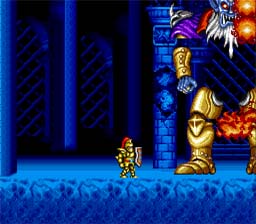 50. Super Ghouls N' Ghosts Super Ghouls 'n Ghosts is a platform game developed by Capcom and initially released for the Super NES console in 1991. It was later ported to the PlayStation, Sega Saturn, Game Boy Advance, PlayStation 2, Xbox, PlayStation Portable, and the Wii Virtual Console. It is the sequel to the arcade games Ghosts 'n Goblins and Ghouls 'n Ghosts. It is perhaps best remembered for possessing immensely difficult and unforgiving gameplay. The game is set four years after Arthur rescued Princess Prin-Prin from the demon Loki. They are engaged, and are about to get married. While spending a quiet moment Prin-Prin is suddenly kidnapped by a demon. Players once again control the Knight Arthur in his effort to save his bride Princess Prin-Prin from the Ghoul Realm. This time, the ruler of the Ghoul Realm is the Demon Emperor Sardius (Samael in the Japanese version). The game is largely similar to its prequels, though it is based more on Ghouls 'n Ghosts. In Super Ghouls 'n Ghosts, Arthur can upgrade to a green armor, that enables him to upgrade his weapons, and the golden one, that allows him to unleash a special magic attack by charging the attack button. A new ability of Arthur is to double jump. While he still can't change directions in mid-air, he can change the direction when he is doing his second jump. Also new this time around is the addition of new weapons. The Bow and Arrow which allows Arthur to shoot two arrows at once and at slightly different angles, and the Scythe. Sticking with tradition, players have to beat Super Ghouls 'n Ghosts twice in a row with a special weapon (Prin-Prin's Bracelet) before being treated to the true ending. The game was a regular on the popular Nickelodeon game show Nick Arcade. |
|
|
|
Post by Seth Drakin of Monster Crap on Oct 24, 2007 9:16:32 GMT -5
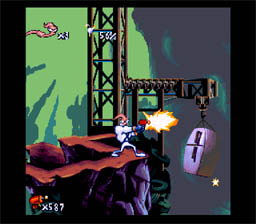 49. Earthworm Jim Earthworm Jim is a run and gun platform video game starring an earthworm named Jim in a robotic suit who battles evil. The game was developed by Shiny Entertainment, released for the Sega Mega Drive/Genesis in 1994, and subsequently ported to the SNES, Game Gear, Game Boy, and years later, the Game Boy Advance. Upon its release it was praised for its detailed animation, polished gameplay and wacky, absurdist humor; it became the first game ever to receive a 100% review in Games Master magazine. A special edition of the game was released for the Sega Mega-CD which features a Red Book audio soundtrack, improved graphics and expanded levels, and an even further enhanced version with redrawn, 256 colour graphics and an Earthworm Jim desktop theme, as well as all the Mega-CD improvements, was released for Microsoft Windows 95. The storyline involves many colorful characters. Jim himself (a character designed by Doug TenNapel) was at first an ordinary Earth earthworm who did very earthworm-like things such as flee from crows and eat dirt. One day, in the space above Earth, the evil Psy-Crow had cornered a rebel spaceship pilot who had stolen an "Ultra-high-tech-indestructible-super-space-cyber-suit" built by Professor Monkey-For-A-Head. The suit had been commissioned by the evil Queen Pulsating, Bloated, Festering, Sweaty, Pus-filled, Malformed, Slug-for-a-Butt so that she could further conquer the galaxy. In the ensuing space fight, the suit was dropped to Earth, and fell on Jim. By a stroke of luck, Jim managed to land within the collar of the suit, and it ended up mutating him into the large and intelligent (at least by earthworm standards) superhero he is today. Jim overhears Psy-Crow talking to Queen Slug-for-a-Butt about the scorch marks left by the suit and her plans for her sister, Princess What's-Her-Name. Jim thus sets out to rescue the princess, fighting many enemies along the way, such as Major Mucus, Chuck and Fifi, Evil the Cat and Bob the Killer Goldfish. |
|
|
|
Post by Seth Drakin of Monster Crap on Oct 24, 2007 9:27:13 GMT -5
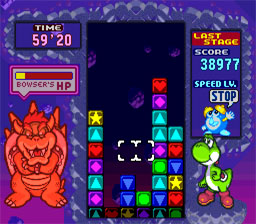 48. Tetris Attack Tetris Attack, known in Japan as Yoshi no Panepon, is a puzzle video game developed by Intelligent Systems and published by Nintendo for the Super Nintendo Entertainment System home video game console and Game Boy handheld game console. The Super NES version was modified for North American and European markets from the original Panel de Pon (released October 27, 1995 in Japan). In Japan, the Super Famicom version of Yoshi no Panepon was not sold at retail, but was released on the Satellaview satellite modem service. Despite the usage of the Tetris name, Tetris Attack uses a different style of gameplay. Instead of falling blocks, Tetris Attack uses rising blocks, which the player must clear quickly enough before the screen fills up. This is done by navigating a rectangle-shaped, two-block long cursor around with the d-pad, causing two blocks to switch positions if the cursor is on them or to move one block left or right. While Panel de Pon uses an original plot and original characters, Tetris Attack takes characters from Super Mario World 2: Yoshi's Island. Tetris Attack has had many sequels for many consoles, including the Nintendo 64, Game Boy Color, Game Boy Advance, GameCube, and the Nintendo DS. The game's single-player story mode takes place in the world of Yoshi's Island, where Bowser and his minions have cursed all of Yoshi's friends. Playing as Yoshi, the player must defeat each of his friends in order to remove the curse. Once all friends have been freed, the game proceeds to a series of Bowser's minions, and then to Bowser himself. During these final matches, the player can select Yoshi or any of his friends to play out the stage. Strangely, almost all of Yoshi's friends in the game are actually enemies from Super Mario World 2: Yoshi's Island, Poochy is the only one to be Yoshi's original friend. Almost all of the characters are having their own partners, that can be seen in their background picture. In Tetris Attack, a cursor is used to move tiles. The cursor can be positioned anywhere within the playing field, a 6 x 12 grid. When the action button is pressed, the two tiles beneath the cursor will exchange position, i.e. they are "swapped" or "flipped". When three or more tiles of the same color are lined up in a row or column (not diagonally), they light up and subsequently disappear from the playing field. Once they are cleared, any tiles that were above them will drop. The cursor is free to move while tiles are disappearing, so players can line up more tiles. When more than three tiles are cleared with a single flip, it is called a combo. Combos are counted on-screen with plain numbers (4, 5, 6, etc.). The maximum number of tiles that can be cleared in a single flip of the tiles during normal play is 14, and anything higher than 10 is rare during routine play. There are some ways done in regular rounds so that 30, the highest registered combo, is shown. Chains are instances when tiles which fall as the result of a clear trigger another clear. The player may rearrange tiles while the clear is taking place in order to cause a chain to occur. If this is timed in conjunction with the falling of tiles, the chain is called a skill chain. Chains are counted on-screen with numbers with an "x" prefix (x2, x3, x4, etc.). The max chain that registers in the game is 13. A chain higher than 13 is recorded as x? and is not worth points. |
|
|
|
Post by Seth Drakin of Monster Crap on Oct 24, 2007 9:32:37 GMT -5
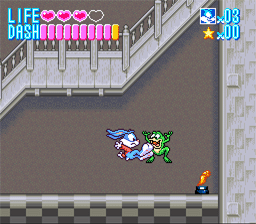 47. Tiny Toons Adventures: Buster Busts Loose Tiny Toon Adventures: Buster Busts Loose (released in Japan as simply Tiny Toon Adventures) is a video game for the Super Nintendo console that is based on the animated TV series Tiny Toon Adventures. It was developed and released by Konami in 1993. This game features Buster Bunny in a side-scrolling adventure that takes place in many different areas. The game has three difficulty settings - "Children" (easy), "Normal", and "Challenge" (hard). On the easy mode, the levels are significantly reduced in size (as notified in the synopsis below), while the hard mode has Buster start each level with only one health unit. As the game begins, Buster realizes he is late for class and dashes off, despite Babs' warning of the escaped animals within. Over the course of the level, Buster continually encounters what appear to be numerous clones of Perfecto Prep student Roderick Rat, as well as frogs and crabs (obviously the animal escapees Babs mentioned). Midway through the stage, Buster will drop into the darkened art room, prompting the appearance of the mini-boss, Arnold the Pitbull. When Arnold is defeated, he drops a key which gives Buster access to the next part of the stage. At the end of the stage, Hamton tells Buster that Dizzy Devil is destroying the kitchen. This segues into the boss fight (which is skipped in the Easy difficulty mode), where Buster has to jump under the conveyor belt on which Dizzy is standing so that nine total pieces of food are consumed by Dizzy. The next stage is the set of a western movie being filmed, which Montana Max claims he is the star of. The first part of the stage has Buster walking through the town, encountering enemies such as the Coyote Kid from the series episode "High Toon" and, for some reason, Barky Marky. At one point, he will need to jump rope ten times (the rope moves faster in the hard mode). He will then enter a five-story building. On the top floor, he catches Max in the act of stealing money from a vault. Max jumps out the window and Buster follows. The second half of the stage (skipped in the easy mode) has Buster chasing after Max on a runaway train. Here, the dash move comes into full force, as at one point the train goes into a low tunnel, forcing Buster to dash over the mountain in order to catch up with the train. The end of the level places Buster on the front car of the train, where the smokestacks are on fire as the train is out of control. Once Buster makes it past the smokestacks, he catches up with Max, who is now begging for his help. The level ends with the two of them jumping onto a hand car and pumping it hard enough to get away from the train, eventually reaching 88 miles per hour and zooming off leaving a fire trail (in a reference to Back to the Future). After clearing the previous stage, it starts to rain, so Buster seeks shelter in a seemingly-abandoned mansion, which he notes is an obvious cliché. The enemies here consist of ghosts, two-headed monsters, evil cakes, and a vampire mini-boss. When played on the easy difficulty, the stage ends after the third room. But if played on the normal or hard modes, Babs will appear at the end of the stage to tell Buster that her friend, Melvin the Monster (from the episode "Hare Raising Night") has been captured and taken under the control of the stage's boss, Dr. Gene Splicer (also from "Hare Raising Night", but referred to as the Mad Scientist in the game itself). In the boss fight, Melvin will throw lightbulbs and screwbolts at Buster, the latter of which Buster must kick so that they hit Splicer's machine, eventually destroying it and thus freeing Melvin. This stage is set in a football game between Acme Looniversity and Perfecto Prep (suspiciously not called by name in the game), with the score at 10-14. Buster is the star receiver on his team and must run the ball 100 yards over the field to score a touchdown and win the game. Plucky Duck, Hamton, and Furrball accompany him here as the team's quarterback, center, and defense, respectively. The Perfectoids will try to tackle Buster as he runs with the ball, and he can only be tackled four times for every ten-yard section of the field. The player can choose to either have Buster simply run with the ball, or have Plucky pass the ball and Buster catch it. The latter method is preferable, as if the player successfully catches the ball, it will have cleared eight yards, and the Perfectoids cannot hurt Buster until he actually has the ball. This stage has a time limit that varies depending on the difficulty mode - 15 minutes on easy (with the clock pausing whenever the ball is fumbled), 7 on normal, and 4 on hard. For this stage, Buster goes up into the sky to retrieve an item that Calamity Coyote accidentally left up there. Buster climbs about the stage by jumping onto bubbles (provided by Hamton), balloons, and pinball flippers. The only enemies in this stage are some buzzards who assault Buster while he's flying on a blimp which appears to be promoting the cartoon itself (it later pops and Concord Condor airlifts Buster to the next part). Once Buster finds the missing item (the script for the next episode), the sky palace where he currently is begins to fall apart and he has dash up the walls and avoid falling off the screen. This stage is skipped completely on the easy mode. The game's final stage is a space setting where Buster plays "a Knight of Honor" who has to rescue Babs, who is in her Princess Leia-based persona from the episode "A Quack in the Quarks". The enemies are all based off of characters who appeared in the episode as well. On the easy mode, the game abruptly ends after the second room, where Buster must avoid giant laser beams by hiding behind barrier walls. The final boss is Duck Vader, also from "A Quack in the Quarks" (although here, he is simply a costumed Plucky, whereas on the show, he was a completely different character), armed with a paralyzing ray gun. To defeat Vader, Buster must knock his flying saucer away from said gun and then kick the gun around so that its rays hit Vader's ship. |
|
|
|
Post by Seth Drakin of Monster Crap on Oct 24, 2007 9:37:35 GMT -5
 46. NBA Jam NBA Jam is a basketball arcade game created by Midway in 1993. It is the first entry in the NBA Jam series, and was written entirely in assembly language. The main designer and programmer for this game was Mark Turmell.[1][2] The release of NBA Jam gave rise to a new genre of sports games which were based around action-packed, unrealistic gameplay. The arcade version features team rosters from the 1992-93 NBA season and the console versions use rosters from the 1993-94 NBA season. Midway did not secure the license to use Michael Jordan's name or likeness, and as such he was not available as a player for the Chicago Bulls or any other team (although Bulls teammate Scottie Pippen was given Jordan-esque attributes, perhaps to make up for this absence). Another notable absence from the home version is that of Shaquille O'Neal, although he did appear on the arcade version, as a member of the Orlando Magic. Midway, no stranger to releasing landmark games (having earlier released Ms. Pac-Man), had started experimenting with the ideas two years earlier, with the High Impact series. Both High Impact and Super High Impact had somewhat average success in arcades. The gameplay of NBA Jam is based on Arch Rivals, another 2-on-2 basketball game released by Midway in 1989. However, it was the release of NBA Jam that brought mainstream success to the genre. The game became exceptionally popular, and generated a significant amount of money for arcades after its release, largely because of the fairly expensive prices put on these games; a game quarter took one or two credits and a full game generally four to eight ($1.00-2.00. Nonetheless, the game was a smash hit. The original arcade release made $1 billion in quarters. |
|
|
|
Post by Seth Drakin of Monster Crap on Oct 24, 2007 9:42:22 GMT -5
Now for the countdown update
150. King Of The Monsters
149. Captain America And The Avengers
148. Bugs Bunny Rabbit Rampage
147. Cannon Fodder
146. Wayne's World
145. Madden NFL 95
144. Metal Warriors
143. Super Godzilla
142. Spider-man & Venom: Separation Anxiety
141. Clay Fighter
140. Super Bomberman 2
139. X-Men: Mutant Apocalypse
138. Kirby's Avalanche
137. Striker
136. Fatal Fury Special
135. King Of Dragons
134. Rap Jam: Volume One
133. Disney's Magical Quest
132. Doom
131. Samurai Shodown
130. International Superstar Soccer
129. Breath Of Fire
128. Sim City 2000
127. U.N. Squadron
126. Desert Strike: Return To The Gulf
125. Daffy Duck: The Marvin Missions
124. Super Battleship
123. S.O.S.
122. Gradius III
121. Tetris 2
120. Lufia II: Rise Of The Sinistrels
119. The Lion King
118. Spider-man & Venom: Maximum Carnage
117. Demon's Crest
116. Pinball Fantasies
115. Inindo: Way Of The Ninja
114. World Cup Striker
113. Run Saber
112. NCAA Football
111. Krusty's Fun House
110. The Simpsons: Virtual Bart
109. Cool Spot
108. Tecmo Secret Of The Stars
107. Super Caesar's Palace
106. Pilotwings
105. Road Runner's Death Valley Rally
104. Romance Of The Three Kingdoms IV: Wall Of Fire
103. Teenage Mutant Ninja Turtles: Tournament Fighters
102. Riddick Bowe Boxing
101. Saturday Night Slam Masters
100. Super Return Of The Jedi
99. Shadowrun
98. Kirby's Dream Course
97. Rock N' Roll Racing
96. NHL 94
95. Madden NFL 97
94. Paladin's Quest
93. Axelay
92. Advanced Dungeons & Dragons: Eye Of The Beholder
91. Wrestlemania: The Arcade Game
90. FIFA International Soccer
89. Super Tennis
88. King Arthur's World
87. Terranigma
86. NBA Live 98
85. WWF Super Wrestlemania
84. Skyblazer
83. Madden NFL 98
82. Street Fighter Alpha 2
81. Soul Blazer
80. Secret Of Evermore
79. Ken Griffey Jr.'s Winning Run
78. Final Fight 3
77. Illusion Of Gaia
76. Parodius: Non-Sense Fantasy
75. Front Mission
74. Harvest Moon
73. Earthworm Jim 2
72. Flashback: The Quest For Identity
71. Super R-Type
70. Mortal Kombat III
69. Super Smash TV
68. Breath Of Fire II
67. The Legend Of The Mystical Ninja
66. Super Empire Strikes Back
65. Final Fight 2
64. Mighty Morphin Power Rangers
63. Mario Is Missing
62. Super Bomberman 3
61. Joe & Mac
60. Super Bomberman
59. Lufia & The Fortress Of Doom
58. R-Type III: The Third Lightning
57. Super Star Wars
56. Sunset Riders
55. Smash Tennis
54. Robotrek
53. Mega Man X3
52. Pocky & Rocky
51. Mega Man X2
50. Super Ghouls N' Ghosts
49. Earthworm Jim
48. Tetris Attack
47. Tiny Toons Adventures: Buster Busts Loose
46. NBA Jam
Here Are The Hints To The Next Five Games On Our List
* Deluxe Superstar Soccer
* EVOlution
* Painting Mario
* Race on Unicycles
* These Guns Are Wild
|
|
|
|
Post by Gopher Mod on Oct 24, 2007 10:14:05 GMT -5
So Mario Paint and Uniracers are coming up soon...
|
|
|
|
Post by Seth Drakin of Monster Crap on Oct 24, 2007 11:02:13 GMT -5
 45. International Superstar Soccer Deluxe International Superstar Soccer Deluxe (short: ISS Deluxe) is the sequel to International Superstar Soccer (ISS), Konami's saga of football (soccer) games. This Deluxe version was published first to the SNES, then the Mega Drive and PlayStation. ISS Deluxe has realistic animations and player sprites. The player can choose from 16 formations and 8 strategies and can compete with 36 national teams with recognizable celebrity players (like Valderrama, Baggio, Ravanelli, Petkov, ...), but their names are fictitious. There are several competitions available: International Cup, World Series (League), Scenario Mode and customizable mini-cups/leagues. |
|
|
|
Post by Seth Drakin of Monster Crap on Oct 24, 2007 11:03:44 GMT -5
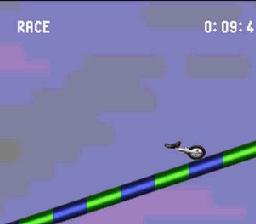 44. Uniracers Uniracers (Unirally in PAL territories, and called 1x1 during development) is a video game that was released for the SNES in 1994 by DMA Design (now Rockstar North). Undoubtedly one of the more unique racing games for the SNES, the gameplay of Uniracers involved racing riderless unicycles around a 2D track. Heavy emphasis was placed on performing stunts. Said stunts either caused the unicycle to go faster on race or circuit tracks (the logic is justified in the instructions) or earn points on stunt tracks. Even the instruction manual was unusual, using an extremely non-serious and tongue-in-cheek tone throughout. A particular example could be the entire page dedicated to the instruction manual itself, which then manages to change the topic to how small pizzas "...are about the size of a CD and cost twice as much." As unicycles are not very well-suited to complex stunts, the stunts that could be performed were relatively simple, mostly only involving jumping in the air and rotating about a given axis in 3D space. The idea was to be able to perform these stunts quickly in tight situations while landing the unicycle on its wheel to avoid wiping out (and losing speed). The game featured nine tours of five tracks each (two race, two circuit, one stunt). Beating each of the first eight tours (Crawler, Shuffler, Walker, Hopper, Jumper, Bounder, Runner, Sprinter) required defeating computer-controlled opponents for each of bronze, silver, and gold ranks. The last circuit, Hunter, featured the Anti-Uni as the computer-controlled opponent. During that tour, touching the Anti-Uni caused several odd effects, such as the track becoming invisible, the controls reversing, and the background no longer moving in sync with the actions. Split-screen two-player modes were available as well, including a league mode that allowed up to eight players to compete in one-on-one races. The game has been listed on the ESRB's website as being a Virtual Console title. |
|
|
|
Post by Seth Drakin of Monster Crap on Oct 24, 2007 11:05:56 GMT -5
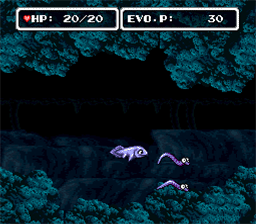 43. EVO: The Search For Eden .V.O.: Search for Eden is a Super Nintendo Entertainment System game developed by Almanic and published by Enix about a character whose goal is to evolve into the dominant life form on Earth and live in Eden where Gaia, a goddess personification of earth, lives. The game's music was composed by Kôichi Sugiyama of Dragon Quest fame. E.V.O. is a side-scrolling platform game with role playing elements. Your character has three basic moves: a jump, tackle, and a melee attack (usually some form of bite), though mammals also have a "kick" option to attack enemies behind them. By eating defeated enemies, players gain "Evolution points" that can be used to modify the creature they are playing as. These improvements include bigger jaws, scales, horns, fins, longer neck, jumping ability, swimming ability, flying ability and more. By evolving, your character gains more hit points, greater speed, stronger attacks, and even certain special abilities such as flight. There are also four types of crystals. Yellow crystals give tips and reveal points of the story. Red crystals allow the main character to morph into special powerful creatures that can be recorded in the evolution log so that they may be called upon later via Green crystals. Green crystals, of which the character may only possess one of at any given time, allow your creature to revert to a past form that was saved into the evolution log. Blue crystals grant the player an unusually large amount of evolution points. The game uses a hub system similar to Super Mario World, with each level consisting of a single overhead map from which the player can choose a variety of stages to play. As the player completes stages within the map, new areas are unlocked for them to explore. E.V.O. tells the saga of life's evolution on Earth, with a subtext of a creation myth. The player takes the role of one of many billions of life-forms created by Gaia, the nurturing and benevolent daughter of Sol (aka God, personified as the sun). Among the creatures known as "life", there is a competition to evolve, and the greatest life-form will eventually be granted the privilege of entering the Garden of Eden and becoming the husband and partner of Gaia. The story takes place over 5 stages of life's evolution: the Age of Fish, the Age of Amphibians, the Age of Dinosaurs, the Age of Mammals, and finally the Age of Eden. As the game progresses, it soon becomes apparent that some mysterious external force is interfering with evolution on Earth in a destructive manner. Strange crystals not native to Gaia appear across the planet, and creatures which eat the crystals are transformed into monstrously powerful beings that dominate all other life-forms, over-consume resources, and disrupt the flow of evolution. In each Age the player character is tasked with confronting the species transformed by the crystals and defeating them so that the evolution of life can continue on track. In the final Age, the Age of Eden, the player learns that a mysterious entity is controlling the world's other life-forms and sending them against the player. This entity turns out to be Bolbox, a life-form that has evolved into a freakish and evil advanced being by consuming the crystals, believing itself to be the first human, but in reality it is a gigantic one-celled organism. In the game's final battle, the player and Bolbox fight to determine who will gain entry into Eden and become Gaia's partner. Bolbox is defeated, and the player joins Gaia in Eden and is granted the gift of intelligence. It is also revealed that the crystals were introduced to Earth by an advanced civilization on Mars, who misguidedly wished to help Earth by speeding its evolution with the crystals. Upon realizing the dangers the crystals create, the Martians decide to leave Earth alone and simply watch it until it becomes advanced enough to interact with Mars. |
|
|
|
Post by Seth Drakin of Monster Crap on Oct 24, 2007 11:12:55 GMT -5
Sorry.....I was looking at a wrong game once again when giving a clue...it has been changed
|
|